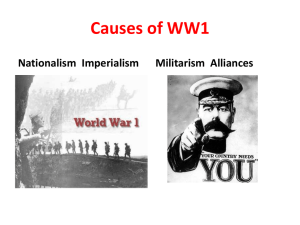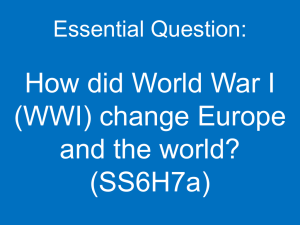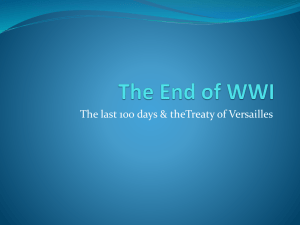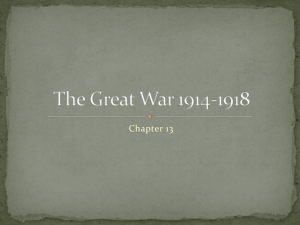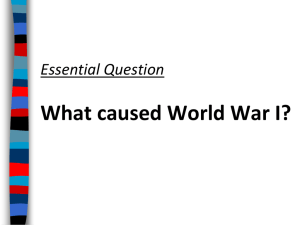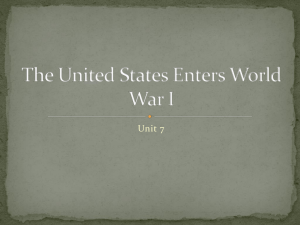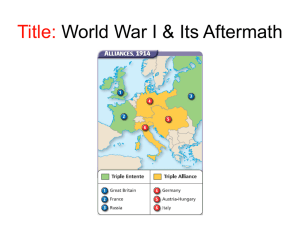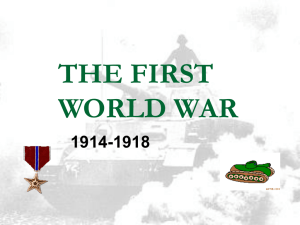WWI and Major Developments Ppt
advertisement
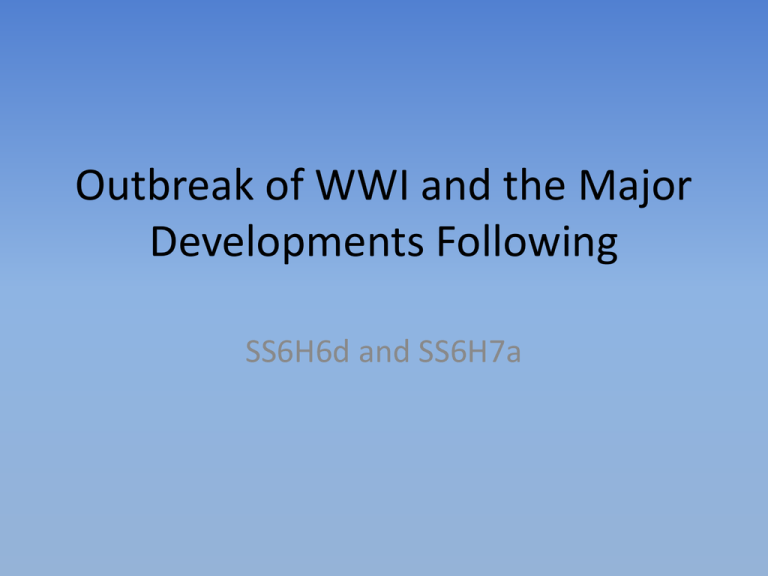
Outbreak of WWI and the Major Developments Following SS6H6d and SS6H7a Essential Question: How did World War I change Europe and the world? Scramble for Africa 1885-1910 Great Britain, France, Portugal, Spain, Denmark, Germany, Italy, Netherlands – divided Africa among themselves Why ? Natural resources Gold, diamonds, oil Politics National pride (more colonies = more status) Worldview Desire to “civilize“ and Christianize Africa Scramble for Asia Europe changed from Asia’s trading partner to Asia’s conqueror British took India French took Vietnam Activating Strategy Based on our activating strategy, we know there were significant changes in Europe following 1914. What happened? World War I Standards: SS6H7a.Describe major developments following World War I: the Russian Revolution, the Treaty of Versailles, worldwide depression, and the rise of Nazism SS6H6d. Explain the impact of European building in Africa and Asia on the outbreak of WWI. Causes of World War I "The Great War was without precedent ... never had so many nations taken up arms at a single time. Never had the battlefield been so vast…never had the fighting been so gruesome..." Causes of World War I Activity Use the MAIN Graphic Organizer to take notes Causes of World War I • Militarism – building up armed forces, getting ready for war • Alliances – agreements or promises to defend and help another country • Imperialism – trying to build up an empire (powerful country that controls several less powerful countries • Nationalism – having pride in your country, willing to defend it Militarism Countries had built strong armies and navies to defend their own countries and their colonies. Tensions built as countries watched each other build up military power. Militarism Can you think of any recent examples of militarism? Alliances European countries had joined alliances to better protect themselves. If one member was attacked, the others were obligated to help that country. How could Germany’s location in Europe be a problem for them? Germany’s problem was that it was in the middle of Europe. Being in the middle made it vulnerable if it came to war. To solve its problem, Germany and other countries formed alliances. By 1914, Europe was divided into two massive alliances. Distributed Summarizing With a seat partner, discuss a time in your life when an alliance (with a friend, family member, or someone else) has caused problems. Imperialism Rivalries developed as countries tried to grab colonies. Conflicts had occurred over control of colonies in Africa and Asia. European countries resented and distrusted each other. Nationalism Pride in one’s country; nations sought their own interests over others. Many groups wanted to be free from the control of other nations. What sparked it all? http://www.youtube.com/watch?v=njINCi9iIrA The events that followed… Austria-Hungary declared war on Serbia Because of the assignation of Archduke Franz Ferdinand in June of 1914 by a Serbian, the emperor of AustriaHungary declared war on Serbia. The events that followed… Austria-Hungary declared war on Serbia Russia sent troops to defend Serbia Russia sent troops to defend Serbia because Russia had a treaty with Serbia. Russia supported Serbia because they were both of a similar ethnic backgrounds. The events that followed… Austria-Hungary declared war on Serbia Russia sent troops to defend Serbia Germany declared war on Russia Since Germany had a treaty with AustriaHungary, Germany declared war on Russia. The events that followed… Austria-Hungary declared war on Serbia Russia sent troops to defend Serbia Germany declared war on Russia Germany declared war on France France had a treaty with Russia so Germany declared war against France. The events that followed… Austria-Hungary declared war on Serbia Russia sent troops to defend Serbia Germany declared war on Russia Germany declared war on France And so the war begins! The Central powers The Allied Powers Austria-Hungary Germany Turkey (Ottoman Empire) Russia France United Kingdom Italy United States Some of the Technological Advances from WWI Aircraft Tank Machine Gun Flamethrower Distributed Summarizing Could World War I have been prevented? Why or why not? Would we have had the technological advances without WWI? Major Developments Following World War I Use the Major Developments in Europe Following WWI Timeline Cartoon Video Clip about the Russian Revolution http://www.youtube.com/ watch?v=KZbho6AsBOc Remember this movie? Romanov Family Czar Nicolas II last czar of Russia and his wife Alexandra (Olga, Tatiana, Maria, Anastasia, and Alexei) Alexei (son) Alexei suffered from hemophilia (lack of clotting in the blood). His illness was a state secret. His great-grandmother was Queen Victoria of Great Britain. Why did the Russian Revolution occur? • For many years before World War I, Russian citizens had suffered under the rule of Tsar (leader) Nicholas II. • The ruling class held the country’s wealth, and the people barely had enough food to eat. • Russia fought on the side of the Allies in World War I and suffered terrible losses. • By 1917, Russians were tired of food shortages, freezing from coal shortages, and exhausted by war. What happened to Russia after the Russian Revolution? • Workers united against the Russian ruler, overthrew the monarchy, and killed Nicholas and his family. • A revolutionary group seized power and established the Soviet Union as a communist country. Bolsheviks The revolutionary group was known as the Bolsheviks (political party—communist) . The Bolsheviks were led by Vladimer Lenin. The Bolsheviks were seen as good and a relief by the suffering people of Russia. Under Lenin, Russia became known as the Union of Soviet Socialist Republics. Union of Soviet Socialist Republics (USSR) After a 3 year civil war, Russia’s traditional monarchy (czar) became the world’s first communistic country. The government of the USSR followed the beliefs of Karl Marx. called Marxism. Karl Marx Distributed Summarizing With a partner, describe in your own words the Russian Revolution and how it changed Russia. The War is Over! The Treaty of Versailles officially ended World War I. What is a treaty? Examining the Treaty of Versailles Activity In small groups, students will examine components of the real treaty to determine the actual decisions that were made. Other groups will examine Germany’s response to the treaty. Examining the Treaty of Versailles Activity If you could use one word to describe the Treaty of Versailles, what would the word be and why? Share your word with an elbow partner. Do you agree with the Treaty of Versailles? Explain why. Share your thoughts with an elbow partner. Treaty of Versailles Requirements (add requirements of the treaty to the Major Developments sheet) • It forced Germany to accept responsibility for causing the war • It required Germany to pay reparations (payments) to other countries for their losses and damage • It required Germany to give up 1 million square miles of land (size of Alaska and Texas combined) much of which was rich in natural resources (Why does this matter?) • It required Germany to limit its armed forces Treaty of Versailles Effects (add requirements of the treaty to the Major Developments sheet) • Germans greatly resented the restrictions put on it by the Treaty of Versailles. • Germans began to rise up in protest as economic conditions worsened. • Germany also became isolated from and distrusted by other countries. Look at the political cartoons below. With an elbow partner, discuss how these represent the Treaty of Versailles. Indemnity means reparation or payment. The World After World War I After World War I • After World War I, the world economy slipped into a worldwide depression. • A depression is a time where business is bad and people lose their jobs. • Soldiers came home needing jobs, but there were not enough. Unemployment skyrocketed. (Listen to “Stony Broke in No Man’s Land”) Worldwide depression • European countries were in bad shape because they had suffered great loss of life and property damage. • Additionally, European countries had borrowed money to pay for war costs and now had no money to repay their debts. • Countries experienced Inflation where their money couldn’t buy as much as it used to buy because it had lost value. How did that affect people? • In 1929, the stock market crash in the United States crippled the already struggling economies. After WWI and Worldwide Depression • Industry, shipping, and trade between countries were affected • Unrest and nationalism grew, people wanted strong leadership to make their countries rich and powerful again Image you are living in Germany after World War I. The world is in the middle of a depression. You do not have enough food, you do not have a job, and you do not believe the leaders of your country can improve the situation. On top of that, your country, the place where you were born and have lived all of your life is being blamed and punished for World War I. Now, read Adolf Hitler’s speech on the Treaty of Versailles in 1923. Watch a video clip of Hitler delivering a speech years later. Why do you think the German people followed Hitler? Rise of Nazism Background: • The democratic government in Germany after World War I (Weimar Republic) faced major problems • A political party called the Nazi Party attracted the attention of dissatisfied Germans • The Nazi Party’s leader, Adolf Hitler, described ideas to strengthen Germany • Hitler also believed that Aryans (Germans) were the “master race”; he had racist feelings about Jews, Slavs, gypsies, and blacks • The Nazi Party believed in a strong central government controlled by the military and run by a dictator Why Nazism grew • Nazis offered solutions for Germany’s economic problems • Nazis appealed to German nationalism by calling for a larger military and an increase in German territory (violation of Treaty of Versailles) • Nazis united Germans against Jews by blaming them for the problems • Nazis assured Germans they could protect them from enemies • Nazis organized groups to threaten anyone who opposed them so few spoke out Distributed Summarizing: The political cartoon shows Adolf Hitler “climbing out” of the Treaty of Versailles. Turn to a seat partner and discuss what is meant by the cartoon. Listen to the National Public Radio story about Germany making its last reparation payment in September 2010. http://www.npr.org/templates/story/ story.php?storyId=130232809 Summarizing Strategy Imagine that you are living in Europe during the 1900s, but you have other family members living on another continent. Write a postcard to your relatives describing the events that you have witnessed from 1913 to 1920. Include World War I and its MAIN causes, the Russian Revolution, economic depression, and the rise of Nazism.
